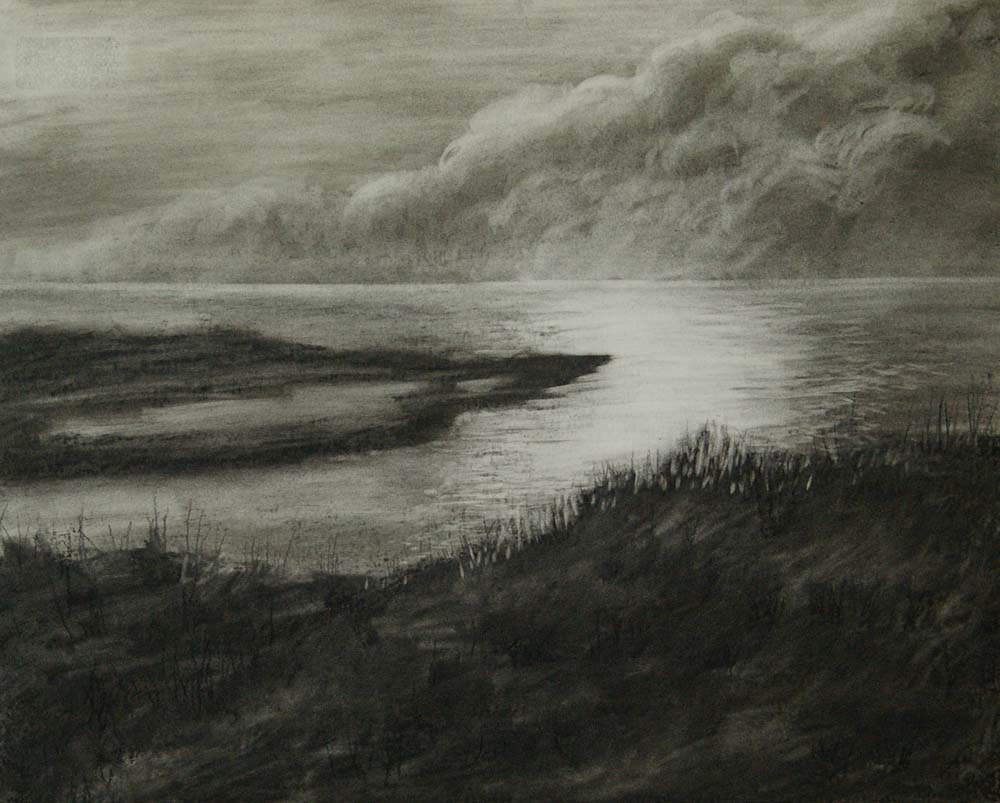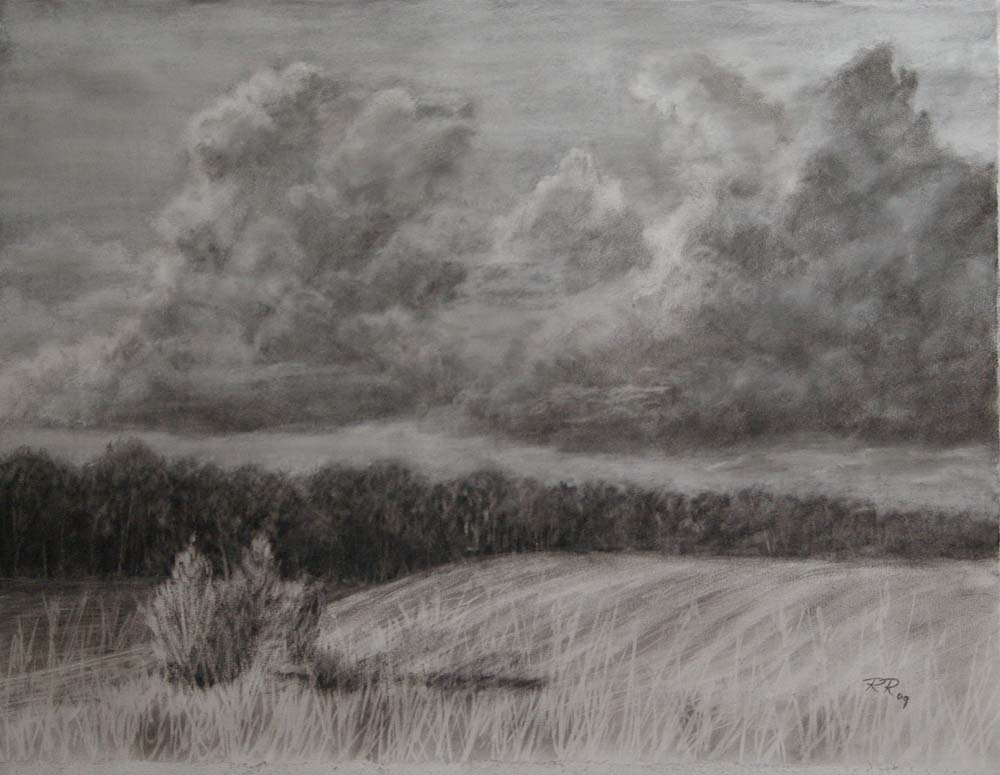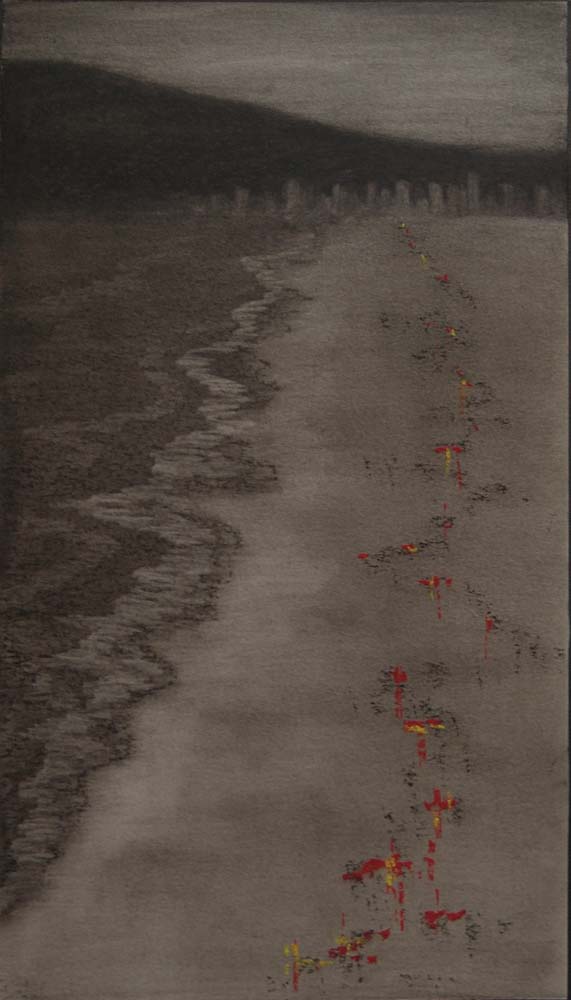Now, before you get worried that I'm turning into a pessimist, let me explain...I'm talking about a technique I've been trying this past few weeks in which you start by adding a layer of black pastel to the paper, and then erase back to the lights (i.e. work negatively). It's an idea I got from an American artist, M. Katherine Hurley (familiarly known as Kay Hurley). According to the DVD I purchased that showcases this technique, she has her students do these as studies, in order for them to really solidly understand value before moving on to colour, but the resulting dramatic greyscale images are worth using the technique for finished works. After watching Kay's video, I decided to try a few myself. My first attempt was a beach scene at Port Franks, with the sun low in the afternoon sky casting a dazzle of light across the surface of the water--just the kind of strong contrasts that are suited to this type of painting. I started by lightly mapping out the big value shapes on my piece of Canson (acid-free) mat board with a dark grey pastel pencil. I chose this support because Kay mentions in her video that the technique does not work on sanded paper, my usual support of choice (the pastel stains the sanded surface, preventing erasure back to white). I decided to work on the reverse side of the board, as the front had a rather mechanical machine texture to it that I didn't want showing up in the painting. First, though, I removed a small price sticker--and as you'll see later, this decision taught me what NOT to do! The residue from that sticker just would not come off or be covered up, and I'll have to crop the final painting to eliminate it. I've left it in the image below to underline the problem--see a small rectangle showing in the sky in the upper left corner? Lesson learned!
Anyway, that realization was yet in the future as I began laying down a fairly even coat of Rembrandt (Kay's recommendation for this technique) black pastel in the areas that would be very dark--the silhouetted grasses and the dune in the foreground. Taking a paper towel (I've heard that Viva is the best to prevent lint on your painting), I rubbed in this section until the black was pretty solid. Then, using the pastel residue on the paper towel, I rubbed in the other values, working darkest to lightest areas, and using more or fewer strokes to obtain the approximate values of grey I wanted in each area. I learned that it's really important to stroke the paper towel ONLY in the direction you want the marks to be--for example, in the sky, I stroked only evenly side to side, to obtain a smooth even coat of grey for the sky. DON'T rub round and round or randomly in what is going to be a smooth area like a sky--these marks will stay, no matter what you do, and you aren't going to add or take away very much in these large lighter grey areas, so there's not much chance to correct it later on. On the other hand, I did use rounded marks in the clouds on the horizon, for sure, to get the billowy, voluminous feeling to them.
So, by then I had the basic value structure laid in, except for the lightest lights. Next I used a variety of erasers, from very hard rubber ones for sharp lines to that putty-like artists' eraser for the very soft shapes (in the cloud). Working back and forth between adding pastel and erasing it out, I developed the details of the scene. I was pretty happy with the resulting dramatic waterscape--very unlike my usual soft, subtle work, but kinda appealing! I called it Smoke on the Water (yup, from the song) for the very smoky effect of the clouds.
My next attempt was from a photo of nearby fields, with another rather dramatic light effect and fabulous cloud structures. This time I tried a Stonehenge watercolour paper, which I actually found more difficult to use--the texture seemed to fight me quite a bit. If I tried this again, I'd be sure to get a hot-pressed paper with a smoother surface. I was again reasonably happy with the result, however, and learned more about the technique while painting Summer Afternoon.
My third try was something quite different--an experiment. Going back to the reverse side of a piece of mat board, I sketched out a scene from a photo I took last week at the Spanish Banks beach in Vancouver. The waterline stretched away from me toward the city skyline, which showed well against the dark mountain shape on the horizon. I'd snapped the photo to capture the gesture of an Asian woman and her little girl, who were walking the beach ahead of me (and this scene may well become a full colour painting someday soon), but it was the dramatic sweep of the shoreline, and the strong contrasts of the skyline against the mountain, that caused me to select it for this greyscale painting. Following the procedure described above, but with a bit more confidence this time, I painted the strong dark shapes and erased out the foaming waterline and skyline shapes. The effect was very graphic.
I had at first thought about adding in a some large calligraphic marks in red pastel to represent the two figures, as a bold contrast to the black & white, and also, somehow, as a statement about the Asian character of Vancouver, how the Chinese culture has had such an effect on the city. But I hesitated--it seemed too political for me, and the large red marks seemed just too MUCH somehow...so I picked up my new Terry Ludwig brilliant red pastel and just touched it gently in sort of random marks along the line of "footprints" on the beach. Yes--that was enough to add a note of brilliance and interest to the somewhat bleak scene. However, when I showed the painting to my husband (always my best critic), he asked if I was going to call it "Blood on the Beach"--yikes! That's not the association I had meant at all! So I added in a brilliant yellow, overlapping some of the red marks, and titled it In the Year of the Dragon. It's entered into the PAC juried show--we'll see if it gets accepted and, if so, whether it ends up in the landscape or the abstract category--it's a bit of both, for sure.
I doubt that this is a direction I'll pursue very much more, but I do think I'll adapt it as an exercise for future students--you REALLY have to think about and understand value in order to do it! It's a great learning tool, and the results are certainly eye-catching.


